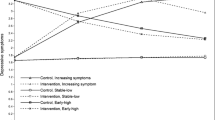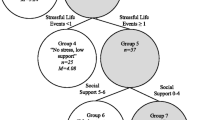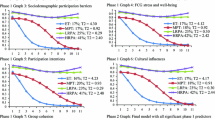Abstract
This study applied latent class analysis to a family-centered prevention trial in early childhood to identify subgroups of families with differential responsiveness to the Family Check-Up (FCU) intervention. The sample included 731 families with 2-year-olds randomized to the FCU or control condition and followed through age 5 with yearly follow-up assessments. A two-step mixture model was used to examine whether specific constellations of family characteristics at age 2 (baseline) were related to intervention response across ages 3, 4, and 5. The first step empirically identified latent classes of families based on several family risk and adjustment variables selected on the basis of previous research. The second step modeled the effect of the FCU on longitudinal change in children’s problem behavior in each of the empirically derived latent classes. Results suggested a five-class solution, where a significant intervention effect of moderate to large size was observed in one of the five classes—the class characterized by child neglect, legal problems, and parental mental health issues. Pairwise comparisons revealed that the intervention effect was significantly greater in this class of families than in two other classes that were generally less at risk for the development of child disruptive behavior problems, albeit still low-income. Thus, findings suggest that (a) the FCU is most successful in reducing child problem behavior in more highly distressed, low-income families, and (b) the FCU may have little impact for relatively low-risk, low-income families. Future directions include the development of a brief screening process that can triage low-income families into groups that should be targeted for intervention, redirected to other services, monitored prospectively, or left alone.


Similar content being viewed by others
References
Achenbach, T. M., & Rescorla, L. (2001). Manual for the ASEBA School-age Forms & Profiles: Child Behavior Checklist for Ages 6-18, Teacher’s Report Form, & Youth Self-Report. Burlington: University of Vermont, Research center for Children, Youth & Families.
Aiken, L. S., & West, S. G. (1991). Multiple regression: Testing and interpreting interactions. Thousand Oaks: SAGE.
Athey, S., & Imbens, G. (2016). Recursive partitioning for heterogeneous causal effects. Proceedings of the National Academy of Sciences, 113(27), 7353–7360. doi:10.1073/pnas.1510489113.
Brennan, L. M., Shaw, D. S., Dishion, T. J., & Wilson, M. N. (2015). The predictive utility of early childhood disruptive behaviors for school-age social functioning. Journal of Abnormal Child Psychology, 43, 1187–1199.
Chamberlain, P., Price, J. M., Reid, J. B., Landsverk, J., Fisher, P. A., & Stoolmiller, M. (2006). Who disrupts from placement in foster and kinship care? Child Abuse & Neglect, 30, 409–424. doi:10.1016/j.chiabu.2005.11.004.
Connell, A. M., & Dishion, T. J. (2008). Reducing depression among at-risk early adolescents: Three-year effects of a family-centered intervention embedded within schools. Journal of Family Psychology, 22, 574–585. doi:10.1037/0893-3200.22.3.574.
Connell, A. M., Dishion, T. J., Yasui, M., & Kavanagh, K. (2007). An adaptive approach to family intervention: Linking engagement in family-centered intervention to reductions in adolescent problem behavior. Journal of Consulting and Clinical Psychology, 75, 568–579. doi:10.1037/0022-006X.75.4.568.
Cooper, B. R., & Lanza, S. T. (2014). Who benefits most from Head Start? Using latent class moderation to examine differential treatment effects. Child Development, 85, 2317–2338. doi:10.1111/cdev.12278.
Dishion, T. J., & Kavanagh, K. (2003). Intervening in adolescent problem behavior: A family-centered Approach. New York: Guilford Press.
Dishion, T. J., & Patterson, G. R. (2006). The development and ecology of antisocial behavior. In: Developmental psychopathology: vol. 3, risk, disorder, and adaptation. (2nd ed., pp. 503–541). Hoboken: Wiley.
Dishion, T. J., Kavanagh, K., Schneiger, A., Nelson, S., & Kaufman, N. K. (2002). Preventing early adolescent substance use: A family-centered strategy for the public middle school. Prevention Science, 3, 191–201. doi:10.1023/A:1019994500301.
Dishion, T. J., Shaw, D., Connell, A., Gardner, F., Weaver, C., & Wilson, M. (2008). The family check-up with high-risk indigent families: Preventing problem behavior by increasing parents’ positive behavior support in early childhood. Child Development, 79, 1395–1414. doi:10.1111/j.1467-8624.2008.01195.x.
Dishion, T. J., Stormshak, E. A., & Kavanagh, K. A. (2011). Everyday parenting: A professional’s guide to building family management skills. Champaign: Research Press.
Dishion, T. J., Brennan, L. M., Shaw, D. S., McEachern, A. D., Wilson, M. N., & Jo, B. (2014). Prevention of problem behavior through annual family check-ups in early childhood: Intervention effects from home to early elementary school. Journal of Abnormal Child Psychology, 42, 343–354. doi:10.1007/s10802-013-9768-2.
Dishion, T. J., Mun, C. J., Drake, E. C., Tein, J.-Y., Shaw, D. S., & Wilson, M. (2015). A transactional approach to preventing early childhood neglect: The Family Check-Up as a public health strategy. Development and Psychopathology, 27, 1647–1660.
Dishion, T. J., Forgatch, M., Chamberlain, P., & Pelham III, W. E. (2016). The Oregon model of behavior family therapy: From intervention design to promoting large-scale system change. Behavior Therapy. doi:10.1016/j.beth.2016.02.002.
Feingold, A. (2015). Confidence interval estimation for standardized effect sizes in multilevel and latent growth modeling. Journal of Consulting Clinical Psychology, 83, 157–168.
Gardner, F., Connell, A., Trentacosta, C. J., Shaw, D. S., Dishion, T. J., & Wilson, M. N. (2009). Moderators of outcome in a brief family-centered intervention for preventing early problem behavior. Journal of Consulting and Clinical Psychology, 77, 543–553.
Hastie, T., Tibshirani, R., & Friedman, J. (2009). The elements of statistical learning: Data mining, inference, and prediction. New York: Springer Science & Business Media.
Herman, K. C., Ostrander, R., Walkup, J. T., Silva, S. G., & March, J. S. (2007). Empirically derived subtypes of adolescent depression: Latent profile analysis of co-occurring symptoms in the Treatment for Adolescents with Depression Study (TADS). Journal of Consulting and Clinical Psychology, 75, 716–728.
Hernan, M., & Robins, J. (2016). Causal Inference. Boca Raton, FL: Chapman & Hall / CRC.
Imbens, G. W., & Rubin, D. B. (2015). Causal Inference in Statistics, Social, and Biomedical Sciences. Cambridge University Press.
Lanza, S. T., & Rhoades, B. L. (2013). Latent class analysis: An alternative perspective on subgroup analysis in prevention and treatment. Prevention Science, 14, 157–168.
Lo, Y., Mendell, N. R., & Rubin, D. B. (2001). Testing the number of components in a normal mixture. Biometrika, 88, 767–778. doi:10.1093/biomet/88.3.767.
Lundahl, B., Risser, H. J., & Lovejoy, M. C. (2006). A meta-analysis of parent training: Moderators and follow-up effects. Clinical Psychology Review, 26, 86–104.
McLachlan, G., & Peel, D. (2000). Finite mixture models. New York: Wiley.
Miller, W. R., & Rollnick, S. (2002). Motivational interviewing: Preparing people for change (2nd ed.). New York: Guilford Press.
Muthén, L. K., & Muthén, B. (2012). Mplus User’s Guide, Seventh Edition. Los Angeles: Muthén & Muthén.
O’Connell, M. E., Boat, T., & Warner, K. E. (2009). Preventing mental, emotional, and behavioral disorders among young people: Progress and possibilities. Washington D.C.: National Academies Press.
Offord, D. R., Boyle, M. H., & Racine, Y. A. (1991). The epidemiology of antisocial behavior in childhood and adolescence. In K. H. Rubin & D. J. Pepler (Eds.), The development and treatment of childhood aggression (pp. 31–54). Hillsdale: Erlbaum.
Olds, D. L. (2006). The nurse–family partnership: An evidence-based preventive intervention. Infant Mental Health Journal, 27, 5–25. doi:10.1002/imhj.20077.
Paul, G. (1967). Strategy of outcome research in psychotherapy. Journal of Consulting Psychology, 31, 109–118. doi:10.1037/h0024436.
Radloff, L. S. (1977). The CES-D scale: A self-report depression scale for research in the general population. Applied Psychological Measurement, 1, 385–401.
Reyno, S. M., & McGrath, P. J. (2006). Predictors of parent training efficacy for child externalizing behavior problems—A meta-analytic review. Journal of Child Psychology and Psychiatry, 47, 99–111. doi:10.1111/j.1469-7610.2005.01544.x.
Rubin, D. B. (1976). Inference and missing data. Biometrika, 63, 581–592.
Sclove, S. L. (1987). Application of model-selection criteria to some problems in multivariate analysis. Psychometrika, 52, 333–343. doi:10.1007/BF02294360.
Shaw, D. S., & Bell, R. Q. (1993). Developmental theories of parental contributors to antisocial behavior. Journal of Abnormal Child Psychology, 21, 493–518.
Shaw, D. S., Dishion, T. J., Supplee, L., Gardner, F., & Arnds, K. (2006). Randomized trial of a family-centered approach to the prevention of early conduct problems: 2-year effects of the family check-up in early childhood. Journal of Consulting and Clinical Psychology, 74, 1–9. doi:10.1037/0022-006X.74.1.1.
Shaw, D. S., Connell, A., Dishion, T. J., Wilson, M. N., & Gardner, F. (2009). Improvements in maternal depression as a mediator of intervention effects on early childhood problem behavior. Development and Psychopathology, 21, 417–439.
Shaw, D. S., Sitnick, S. L., Brennan, L. M., Choe, D. E., Dishion, T. J., Wilson, M. N., & Gardner, F. (2017). The long-term effectiveness of the Family Check-Up on school-age conduct problems: Moderation by neighborhood deprivation. Development and Psychopathology, FirstView, 28, 1471–1486 1–16. doi:10.1017/S0954579415001212.
Shelleby, E. C., Shaw, D. S., Dishion, T. J., Wilson, M. N., & Gardner, F. (under review). Effects of the Family Check-Up intervention on reducing growth in conduct problems from toddlerhood through school age: An analysis of moderated mediation.
Smith, J. D., Berkel, C., Hails, K. A., Dishion, T. J., Shaw, D. S., & Wilson, M. N. (2017). Predictors of participation in the Family Check-Up program: A randomized trial of yearly services from age 2 to 10 years. Prevention Science, 1–11.
Sterba, S. K., & Bauer, D. J. (2010). Matching method with theory in person-oriented developmental psychopathology research. Development and Psychopathology, 22, 239–254. doi:10.1017/S0954579410000015.
Tein, J.-Y., Coxe, S., & Cham, H. (2013). Statistical power to detect the correct number of classes in latent profile analysis. Structural Equation Modeling: A Multidisciplinary Journal, 20, 640–657. doi:10.1080/10705511.2013.824781.
Author information
Authors and Affiliations
Corresponding author
Ethics declarations
Funding
This research was supported by the National Institute on Drug Abuse (NIDA) grant DA036832-01A1 to the second, fourth, and fifth authors. The first author was supported during preparation of this manuscript by a NIDA T32 DA039772.
Conflict of Interest
Dr. Dishion is the developer of the Family Check-Up program. The remaining authors declare that they have no conflicts of interest.
Ethical Approval
All procedures performed in studies involving human participants were in accordance with the ethical standards of the institutional and/or national research committee and with the 1964 Helsinki Declaration and its later amendments or comparable ethical standards.
Informed Consent
Informed consent/assent was obtained from all participants in this study.
Electronic supplementary material
ESM 1
(DOCX 19 kb)
Rights and permissions
About this article
Cite this article
Pelham, W.E., Dishion, T.J., Tein, JY. et al. What Doesn’t Work for Whom? Exploring Heterogeneity in Responsiveness to the Family Check-Up in Early Childhood Using a Mixture Model Approach. Prev Sci 18, 911–922 (2017). https://doi.org/10.1007/s11121-017-0805-1
Published:
Issue Date:
DOI: https://doi.org/10.1007/s11121-017-0805-1




